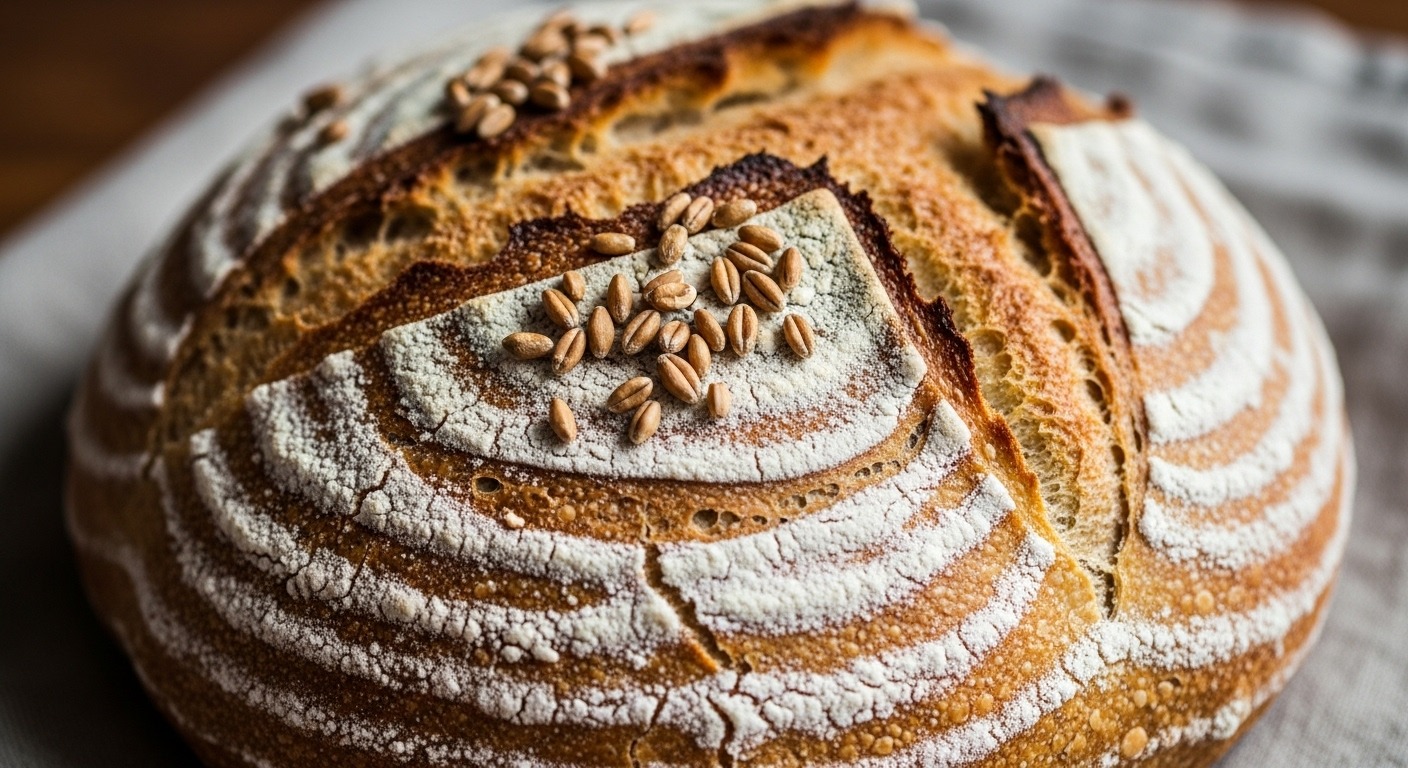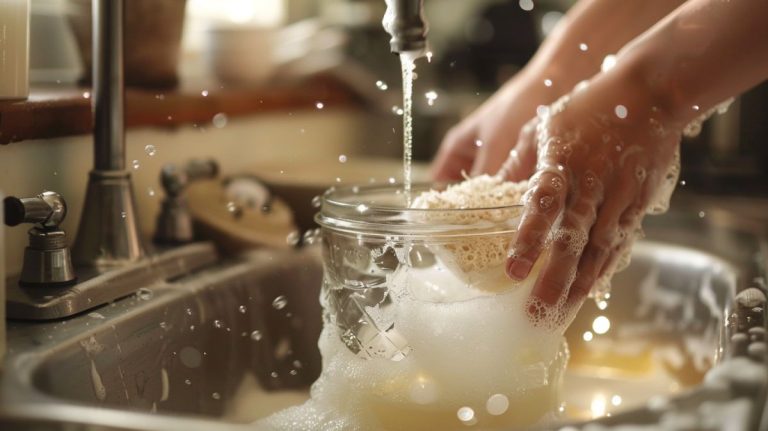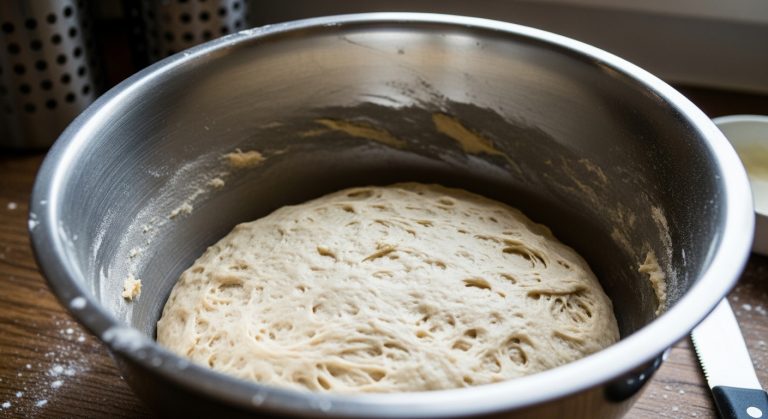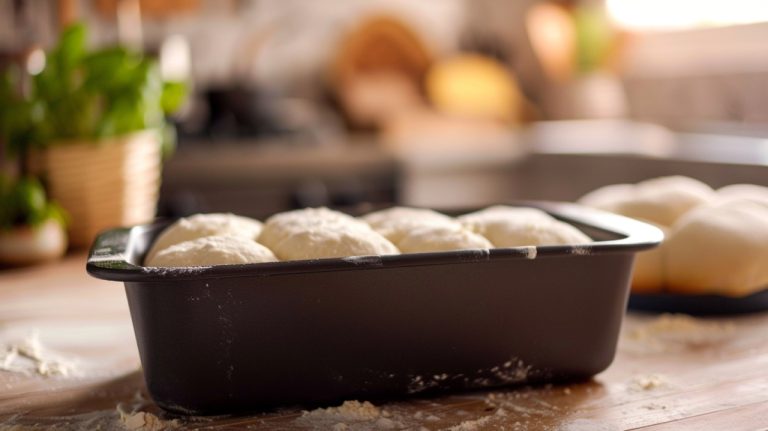Cracked Wheat Sourdough Bread: Open Crumb, Bold Flavor
Cracked wheat sourdough isn’t just bread—it’s a flavor revolution waiting to happen in your kitchen. This hearty grain adds incredible texture and nutty depth that store-bought loaves can’t match. But here’s the challenge: most home bakers end up with dense, heavy results instead of the light, airy crumb they’re after.
The secret lies in proper grain preparation and timing your fermentation perfectly. This comprehensive guide walks you through every step, from selecting the right wheat to achieving professional-level oven spring. You’ll learn the hydration tricks that prevent gummy texture and discover why autolyse timing makes all the difference.
Ready to create bakery-quality bread that’s packed with 25% more fiber than regular sourdough? Let’s dive into the techniques that will make your kitchen smell like a European artisan bakery.
Key Takeaways
- Soak cracked wheat in boiling water until soft before mixing with sourdough starter, salt, honey, and whole wheat flour for optimal hydration.
- Perform repeated stretch and folds during bulk fermentation at 24–26°C to develop gluten and improve dough strength and texture.
- Cold-proof the shaped dough overnight to enhance flavor complexity and gluten structure before baking in a preheated Dutch oven.
- Score the dough at a 45° angle, ¼–½ inch deep, to control expansion and prevent crust cracking during high-temperature baking.
- Use steam or a Dutch oven for baking to achieve a crisp crust and tender crumb, cooling bread on a wire rack before slicing.
Cracked Wheat Sourdough Bread Recipe Table
| Ingredients | Process |
|---|---|
| 3½ oz (½ cup) cracked wheat | Pour 8 oz boiling water over cracked wheat in mixing bowl. Let cool until water is absorbed and grains are soft (about 20 minutes) |
| 8 oz (1 cup) active sourdough starter | In large bowl, combine starter with 2 oz warm water and 2½ oz bread flour. Mix to form thick batter. Cover and rest 30-60 minutes |
| 2 oz (¼ cup) warm water | Use to activate starter mixture |
| 5 oz (1 cup) bread flour (divided) | Add remaining flour gradually during mixing |
| 1 tsp salt | Add with cooled cracked wheat mixture |
| ¾ oz (1 tbsp) honey | Mix in with wet ingredients for flavor and fermentation |
| 5 oz (1 cup) whole wheat flour | Incorporate after adding cracked wheat |
| 1 egg + 1 tbsp water (optional) | Whisk together for egg wash before baking |
| Extra cracked wheat and seeds | Use for garnish on top of loaf |
Cracked Wheat and Its Role in Bread
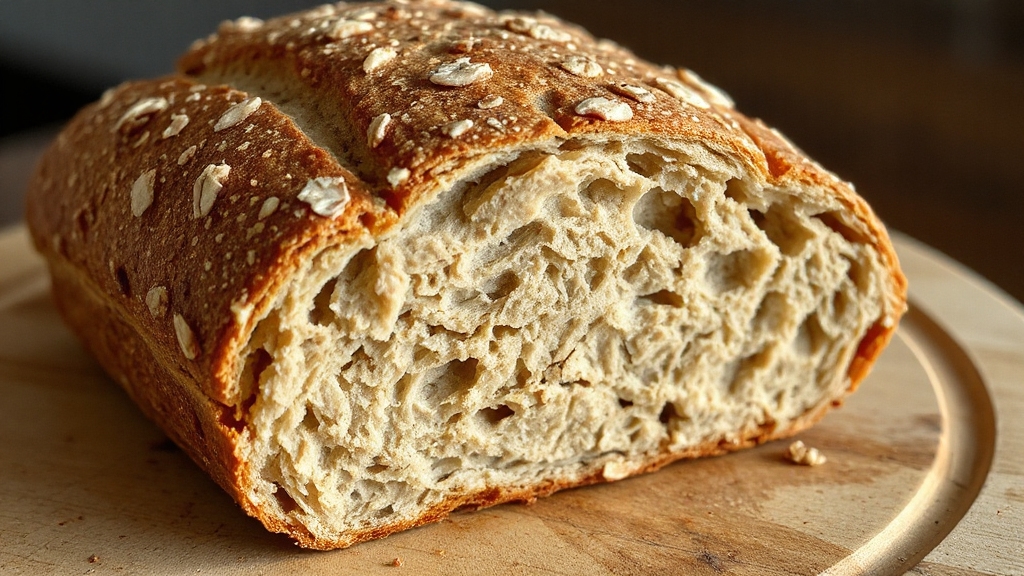
While cracked wheat might seem like just another grain, its unique composition and processing considerably influence the quality and nutrition of your bread.
Cracked wheat retains the bran, germ, and endosperm, preserving essential nutrients like fiber, protein, iron, and B vitamins. With about 6 grams of fiber and 8.7 grams of protein per 100 grams, it notably boosts your bread’s nutritional density.
Each slice of Heidelberg Bread’s Cracked Wheat bread contains no added sugars or trans fats, making it a heart-healthy choice. Additionally, incorporating cracked wheat can enhance the texture and rising of artisanal bread, contributing to a more satisfying chew and crumb.
Cracked wheat’s intact bran, germ, and endosperm enrich bread with fiber, protein, iron, and B vitamins.
Its 74% carbohydrate and 13% fat content contribute energy and mouthfeel, while 2 mg of iron per slice supports oxygen transport in your body. The grain’s antioxidant properties protect cells from oxidative stress, enhancing your bread’s health benefits.
This nutrient-rich profile not only elevates the bread’s function as sustenance but also adds a distinct nutty flavor and rustic texture that artisanal bakers cherish.
Preparing and Mixing the Dough
Before you combine any ingredients, you need to properly prepare the cracked wheat by soaking it in boiling water until it fully absorbs the liquid and softens. This hydration step is vital for seamless dough integration without pre-cooking.
Next, mix your active sourdough starter with warm water and part of the bread flour to form a thick batter, then rest it 30–60 minutes to activate fermentation. According to the recipe, the warm water should be between 120-130°F to optimize yeast activity and dough consistency.
Incorporate the soaked cracked wheat along with its soaking liquid, salt, honey, and whole wheat flour into the wet mixture. The dough will become sticky—knead by hand or mixer until it pulls away from bowl sides, adding flour gradually if needed.
Stretch and fold the dough repeatedly to develop gluten strength, preparing it for fermentation and shaping.
Managing Your Sourdough Starter for Best Results
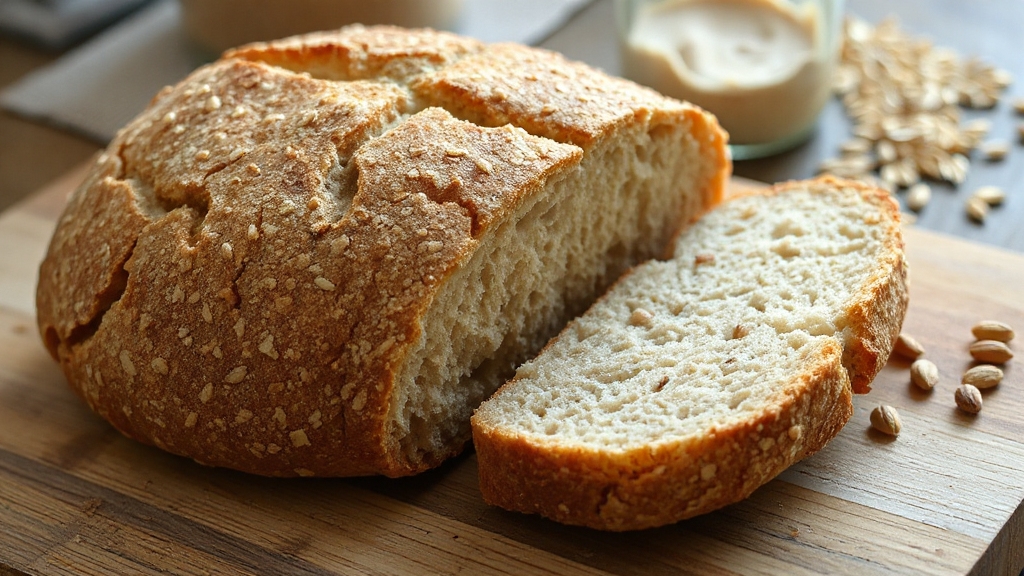
To achieve a lively, robust starter for your cracked wheat sourdough, you’ll want to establish a consistent feeding schedule that matches its activity and your baking rhythm. Refreshing involves discarding part of the starter and adding fresh ingredients; common ratios include 30% whole grain flour and 70% bread flour.
Storing your starter at around 75°F keeps fermentation vibrant, while refrigeration slows it down, preserving strength when you’re not baking. The choice of flour, such as all-purpose flour, significantly affects the starter’s growth and consistency. Mastering these timing and temperature controls guarantees your starter remains balanced, acidic, and ready to impart complex flavors.
Starter Feeding Schedule
Because maintaining a consistent feeding schedule directly influences your sourdough starter’s importance, you’ll need to tailor feedings based on temperature, starter maturity, and activity levels.
At room temperature, feeding every 12–24 hours works, but young or weak starters demand feedings every 8–12 hours to build strength. Wild yeast comes from various sources and is less predictable than commercial yeast, so understanding your starter’s unique behavior is essential. Using a digital kitchen scale ensures precise measurements for feeding, which supports consistent starter activity.
Observe your starter’s peak—usually 8–12 hours post-feed—and feed just after to maintain vigor.
Adjust feeding ratios to control fermentation speed: a 1:1:1 ratio suits daily feedings, while 1:3:3 or 1:4:4 extends intervals by slowing activity.
Warm environments require more frequent feeding, cooler ones less.
Watch for doubling volume, consistent bubbles, and a tangy aroma as health indicators.
If your starter deflates or smells off, increase feeding frequency or ratio.
This precision guarantees a robust starter, ready for crafting your cracked wheat sourdough bread.
Optimal Starter Storage
Maintaining a lively starter through precise feeding sets the stage for how you store it, which directly affects its performance and longevity. If you bake frequently, keep your starter at room temperature in a consistent, warm spot—never near hot or cold drafts.
Temperature significantly impacts fermentation speed; warmer temperatures accelerate fermentation, so choose a warm area to encourage active yeast growth.
For occasional bakers, refrigeration suits best; feed your starter, thicken its hydration, then allow it to begin fermenting at room temperature before chilling. Use glass jars for visibility and non-reactivity, or plastic and deli containers for practicality, always with airtight lids to prevent contamination. Label your container with feeding dates.
When retrieving refrigerated starter, reactivate it with multiple room temperature feedings until it bubbles and rises vigorously. For long-term security, dry a portion of your starter—label and store it for easy revival, ensuring your cracked wheat sourdough never loses energy.
Techniques for Proper Fermentation and Rising
When you master the delicate balance of fermentation and rising, your cracked wheat sourdough bread transforms from simple dough into a complex, flavorful masterpiece. During bulk fermentation, maintain dough temperature between 24–26°C to optimize gluten strength and yeast activity.
Fold the dough gently every 30 minutes to redistribute gases and enhance structure. After shaping, cold proof the dough overnight to deepen flavor and improve crumb texture. Always watch for the dough’s puffiness and perform the poke test to ensure proper fermentation. Using a Dutch oven with even heat distribution can significantly improve crust development during baking.
| Step | Key Technique |
|---|---|
| Autolyse | Hydrate flour 30–60 min for gluten |
| Bulk Fermentation | 3–7 hrs at 24–26°C, fold 3–4 times |
| Folding | Use wet hands, gentle dough stretch |
| Cold Proof | Refrigerate 12–14 hrs for flavor |
| Final Rise | Room temp until dough passes poke test |
Baking Tips for Perfect Crust and Crumb
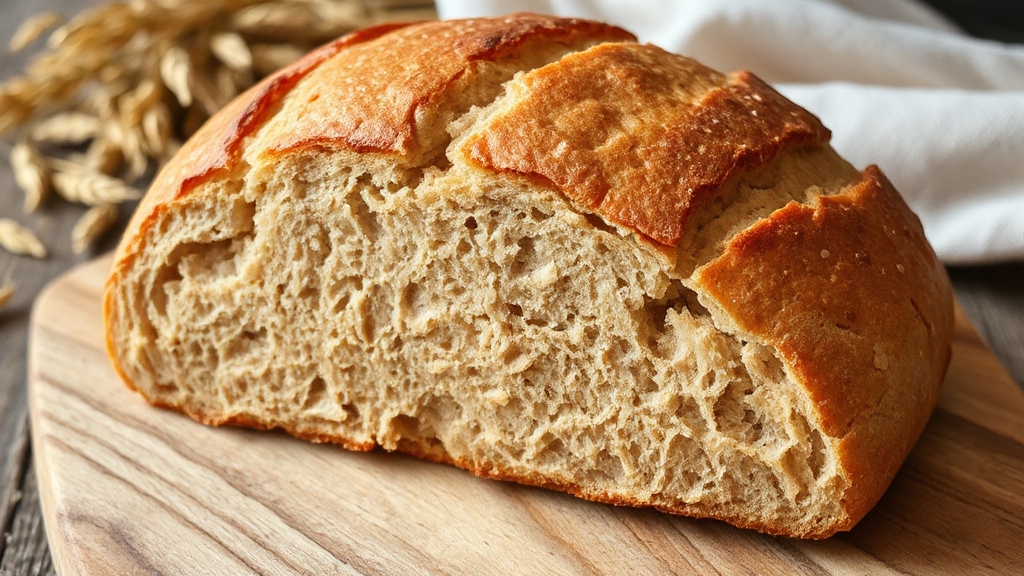
Achieving the perfect crust and crumb starts long before the bread hits the oven, but the baking phase ultimately defines your loaf’s character. You’ll want to preheat your Dutch oven for at least 30 minutes at 450–500°F to lock in heat and create steam, critical for oven spring and a glossy crust.
Score the dough with a razor at a 45° angle, cutting ¼–½ inch deep to control expansion and prevent random cracks. After 20–25 minutes covered, remove the lid to brown and harden the crust, lowering the temperature slightly. Using steam during baking helps develop a crisp exterior and tender crumb.
Remember to:
- Shape dough tightly, using flour or wet hands to handle sticky cracked wheat.
- Cool on a wire rack at least 30 minutes before slicing to set crumb.
- Tap the bottom for a hollow sound confirming doneness.
Because cracked wheat includes the bran, germ, and endosperm, it preserves the bread’s full grain nutrition and adds hearty flavor. Proper rising in a warm, draft-free environment further enhances texture and flavor in whole grain breads.
Nutritional Benefits of Cracked Wheat Sourdough
You’ll appreciate how cracked wheat sourdough delivers a high fiber punch that fuels your digestive health and keeps you full longer. Its natural fermentation introduces probiotics, enhancing gut flora and nutrient absorption.
These fermentation processes also improve the bioavailability of minerals, making the bread more nutritious. Choosing flours with high protein content like cracked wheat can also improve the bread’s texture and fermentation quality.
Plus, the lower glycemic index helps stabilize your blood sugar, making it a smart choice for sustained energy.
High Fiber Content
A single cup of cracked wheat packs an impressive 25 grams of dietary fiber, making it a powerhouse ingredient for anyone looking to boost their fiber intake through sourdough bread. This high fiber content not only supports regular bowel movements but also helps regulate blood sugar and lower cholesterol, contributing to overall cardiovascular health.
Additionally, cracked wheat is low in calories, providing only 120 kcal per serving, which makes it suitable for those mindful of their energy intake. Using organic flour like cracked wheat can also help maintain a healthy sourdough starter by providing essential nutrients for yeast and bacteria.
When you incorporate cracked wheat into your sourdough, you’re enhancing the bread’s nutritional profile while enjoying a delightfully chewy texture.
Imagine biting into bread that offers:
- A robust, nutty flavor with each fiber-rich crumb
- A satisfying chewiness that signals wholesome grain presence
- A slow, steady energy release thanks to complex carbohydrates and fiber
Probiotic Advantages
While probiotic bacteria don’t survive the baking process, cracked wheat sourdough still delivers remarkable gut health benefits thanks to its rich prebiotic fibers and the lactic acid produced during fermentation.
These prebiotic fibers act as nourishment for beneficial gut microbes, fostering a balanced microbiome essential for optimal digestion.
The lactic acid not only enhances nutrient bioavailability—particularly minerals like iron and vitamins such as folic acid—but also exhibits antioxidant properties that protect your cells from oxidative stress. Additionally, lactic acid bacteria help break down gluten and reduce digestive discomfort, making the bread easier to digest.
By reducing phytate content, fermentation further improves mineral absorption. This synergy supports immune function and aids in maintaining gut integrity. Additionally, cracked wheat sourdough has a lower glycemic index compared to white and non-fermented whole-wheat bread, which helps in better blood sugar management.
When you enjoy cracked wheat sourdough, you’re tapping into an ancient, scientifically validated process that promotes digestive health beyond what ordinary bread can offer, making it a true functional food.
Lower Glycemic Index
Beyond supporting your gut microbiome, cracked wheat sourdough offers a significant advantage in managing blood sugar through its lower glycemic index. The sourdough fermentation process produces lactic acid, which slows carbohydrate digestion, resulting in a glycemic index around 54—considerably lower than white or whole wheat bread.
This slower digestion also contributes to the open crumb structure characteristic of well-fermented sourdough breads, promoting a satisfying texture. However, it is important to note that plain cracked-wheat bread generally has a high glycemic index due to its carbohydrate content.
This means your blood sugar rises more gradually, helping maintain stable energy levels and reducing insulin spikes. When you choose cracked wheat sourdough, you benefit from:
- A complex carbohydrate matrix that digests slowly
- Enhanced mineral absorption through phytate breakdown
- A moderate glycemic response that supports long-term metabolic health
Cultural Significance of Sourdough Baking
Because sourdough bread has been intertwined with human history for millennia, its cultural significance runs deep and wide. You’ll find its roots in the Fertile Crescent and Ancient Egypt, where accidental fermentation birthed this staple.
Archaeological finds in Switzerland date sourdough back to 3,700 BC, underscoring its ancient lineage. Utilizing precise techniques such as an adjustable cake leveler can help achieve even layers in sourdough sandwich bread, enhancing both appearance and texture.
Sourdough’s origins trace back to Ancient Egypt and the Fertile Crescent, with roots dating as far as 3,700 BC.
When you bake sourdough, you partake in a tradition pivotal during the California and Klondike gold rushes, where miners—dubbed “sourdoughs”—relied on its reliable natural leavening. This practice was essential because commercial yeast was not readily available, making sourdough starters a vital resource for sustenance during that era California Gold Rush.
San Francisco’s iconic sourdough reflects French bakers’ influence, shaping local culture and economy. You engage with a craft fostering community, as starters and recipes are shared.
This natural fermentation technique, reliant on wild yeast and bacteria, connects you to centuries of artisanal practice, underscoring sourdough’s enduring cultural resonance.
Experimenting With Variations and Flavor Enhancements
Sourdough’s rich heritage invites you to experiment boldly with grains, hydration, and flavor to craft a loaf that’s uniquely yours. Start by blending cracked rye, spelt, or oats with cracked wheat to diversify texture and taste.
Adjust your hydration between 65% and 82%, soaking cracked grains to control dough stickiness and crumb openness. Soaking the grains for about two hours in hot water softens them without extensive cooking, preserving their texture and preventing damage to teeth during eating soaking grains.
Enhance flavor complexity by balancing salt, honey, or oil, and finish with a seed garnish or egg wash for visual and textural contrast.
- Coarse cracked grains deliver a pronounced bite, while finer cracks yield subtle chewiness.
- Cold-proof your dough overnight to deepen flavor and strengthen gluten.
- Use multiple folds during bulk fermentation to build structure and improve oven spring.
Frequently Asked Questions
Can Cracked Wheat Sourdough Bread Be Frozen for Later Use?
You can absolutely freeze sourdough bread for later use, preserving its texture and flavor. Make sure it’s completely cooled, then wrap it tightly in plastic or foil to lock in moisture.
Place it in a freezer bag, remove air, and double bag if you want extra protection against freezer burn.
Slice before freezing for easy defrosting.
When ready, defrost at room temperature or toast directly to restore freshness and crispness efficiently.
What Kitchen Tools Are Essential for Baking Cracked Wheat Sourdough?
You don’t just throw flour and water together and hope for a masterpiece, right? You’ll need a digital scale for precise measurements and a sturdy stand mixer or wooden spoon to handle sticky dough.
A bench scraper and dough scraper will keep your workspace neat, while a banneton shapes your loaf beautifully. Don’t forget a Dutch oven for that perfect crust and an oven thermometer to nail the ideal baking temperature every time.
How Does Altitude Affect Cracked Wheat Sourdough Bread Baking?
You’ll notice altitude speeds up fermentation because of lower air pressure and drier air, so you’ll need to reduce your starter or yeast.
Dough tends to be wetter and stickier, so you’ll want to add more flour for structure.
Higher altitude also means increasing liquid by a tablespoon or two and raising oven temperature by 15-25°F to set the crust quickly.
Keep a close eye on proofing to avoid over-fermentation and collapse.
Are There Common Allergens in Cracked Wheat Sourdough Bread?
Allergens in cracked wheat sourdough bread are like hidden landmines if you’re sensitive. You’ll find wheat and gluten, which you must avoid if you have allergies or celiac disease.
Though fermentation reduces gluten somewhat, it doesn’t eliminate it. Cross-contamination with soy or nuts can occur during processing, so always check labels carefully.
If you’re allergic to wheat or gluten, steer clear to protect your health and avoid unpleasant reactions.
What Is the Best Way to Store Leftover Cracked Wheat Sourdough Bread?
You should store leftover sourdough bread at room temperature, ideally between 60–70°F, after letting it cool completely to avoid sogginess. Place it cut side down on a board and cover with a breathable tea towel to maintain moisture.
For longer freshness, double-wrap it—first in paper or cloth, then plastic. Avoid refrigeration unless in humid conditions, as cold makes bread stale faster.
Freeze only when fully cooled, tightly wrapped to prevent freezer burn.
Artisan Results, Nourishing Rewards
Now that you’ve mastered cracked wheat sourdough, you’ll see how its coarse texture enhances fermentation, creating a uniquely tangy, hearty crumb. Contrary to popular belief, cracked wheat doesn’t weaken gluten structure—it actually encourages a more open, chewy loaf when mixed and fermented properly.
Embrace precise hydration and timing to reveal its full potential. Your hands-on care transforms simple grains into complex flavors, making each loaf a nourishing, artisanal masterpiece you’ll proudly share.

